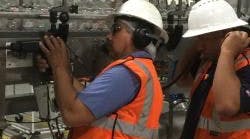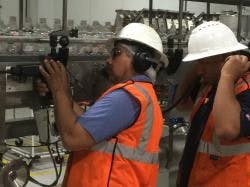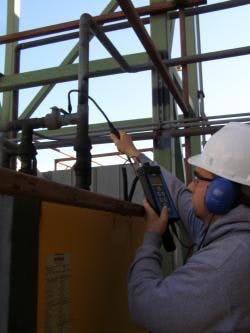Restart your PdM program, Part 1: The rocky road to reliability
If you’ve ever had to restart a predictive maintenance (PdM) program, you’re not alone. Everyone seems to have at least one story about a PdM initiative that failed or was ineffective. How can you make sure yours will go right when it’s launched and perform well over the long haul?
Share the findings that result from PdM, such as this ultrasonic bearing inspection on a high-speed bottling line. Source: The Wonderful Company
So many reliability professionals were eager to share their advice and experiences that this story will be presented in two parts. The common themes and unique pearls of wisdom will help you to avoid the costs and frustration of PdM restarts and put your program on the path to lasting success.
The rocky road to reliability
Programs that fail often go out with a whimper. “I found ultrasound and infrared devices in a dust-covered box in a cabinet when I was hired here 10 years ago,” says Brendon Russ, reliability engineer at Southern Gardens Citrus, a division of US Sugar. “My job was to restart a multifaceted PdM program that had been dropped.”
The plant had fallen into the trap of thinking that PdM would result from just buying a tool. This had caused previous PdM attempts to fail, explains Russ. “There was this thought that by buying this device, we now have PdM, and life would be great,” he says. “There wasn’t really any foresight into building a PdM program, including the processes and procedures to govern the use of PdM or the training and information-sharing needed for others to understand the program and its value.”
- Production doesn’t see the value and therefore provides reluctant support, characterized by not making equipment available to take readings.
- The PdM group doesn’t act on the data derived from the PdM monitoring, lessons aren’t learned, and equipment continues to fail.
- The PdM group fails to employ the correct metrics such as cost avoidance and consequently no one understands the contribution the program is making to the business.
- The PdM group isn’t provided adequate training upfront or annual refresher training as the program matures, and their skills diminish along with accurate data collection.
- The management team doesn’t understand the value the PdM group can deliver and consequently doesn’t provide leadership support such as asking challenging questions, removing barriers, reviewing key metrics, insisting that the PdM group deliver results and the organization act on those results; and providing adequate funding.
- The chosen PdM group leader has an inadequate skill set.
Source: Marshall Institute
Shayne Jones, O&M manager for maintenance at Salt River Project (SRP) Navajo Generating Station witnessed a PdM initiative fail for common reasons. “There was a lack of visible support from management; no synergy; employee turnover; poor communication of program value to equipment owners, maintenance, and operations staff; and infrequent promotion of finds and saves,” remarks Jones.
It used to be that the PdM technology caused problems, but now the technology is so easy to use that the problems stem from the people and their actions (or lack thereof), says Michael Trainor, manager of asset reliability consulting at SKF.
“One plant had a mill motor on a critical sawing operation indicating a problem over three months, and even though the vibration analysis was very sound and the work request entered in the CMMS was adequate, the mill’s maintenance team took no corrective action. In the third month, the critical motor had a catastrophic failure,” says Trainor. “The team’s inaction caused eight hours of downtime, more than $18,700 in repair work costs, and roughly $950 of mechanic labor costs.”
Many companies will initiate a PdM program and then check the task off their list as done. This always leads to failure, suggests Joe Anderson, senior reliability manager at The Schwan Food Company (Schwan). “I have witnessed a few failures and walked into plants that have remnants of what was once a good program,” he says. “Usually it was due to a combination of three things: The program manager failed to show the value PdM provided to the organization, the management changed, (and/or) there was insufficient knowledge and training.”
[sidebar id="6"]
Bob Kazar, director of reliability for operational excellence at The Wonderful Co., agrees that the majority of programs fail because of a lack of leadership support, which leads to a loss in momentum and continuity. The one exception to this rule he saw was a fairly large Texas plant with a strong PdM department, many technicians carrying multiple certifications, and numerous predictive technologies in use. “Despite strong middle management support, one short-term plant manager wanted to make a point by reducing the department to one PdM technician,” says Kazar.
“Of course, the PdM backlog skyrocketed and only the most critical routes and assets received attention,” he continues. “After six months, the plant manager boasted that he was proven correct in that the site no longer needed the PdM team. Sadly, the reduction in reliability hit hard within nine to 12 months, but by then the plant manager had left the company. Eventually the plant would recover but not as the division showcase that it once was.”
The Southern Gardens Citrus PdM restart was on par with a new implementation. Source: Southern Gardens Citrus
Most companies do PdM because it’s the right thing to do, says Tracy Strawn, president of oil and gas services at Marshall Institute, but in many cases the program is either poorly implemented or poorly managed. “About 75% of all the PdM programs I have evaluated as a consultant are ineffective or failing to deliver,” Strawn says. “They start out with great intentions, but the program is not implemented thoroughly or completely, or the program is downsized to the point of delivering little value as a result of a plantwide austerity or cost-cutting program.”
When programs aren’t set up correctly in the first place, they’ll never be as effective or efficient as they otherwise could be. “When reliability practitioners have a vibration program but ‘don’t have enough time’ to use other PdM technologies, that’s when I know there are missed opportunities,” says reliability improvement specialist Paul Dufresne. “Their technician may be spending four to eight hours collecting vibration data and then eight to 16 hours analyzing the data, but if the database had been set up properly to allow the software to do the analysis, it would have cut down on that time and allowed the technician to use other tools in the PdM toolbox.”
Training is another area of opportunity, says Dufresne. “I have seen organizations make an investment in the software and hardware but cut training out of the project.”
Another sign of ineffective implementation is repeat failures. “We often wonder why there are so many repeat failures in the thousands of machines that are being monitored,” remarks consulting engineer Heinz P. Bloch. “The problem is twofold: It has to do with uninformed management and a tradition-focused workforce. What is needed is a long-term reliability improvement program that includes root-cause identification and correction.




